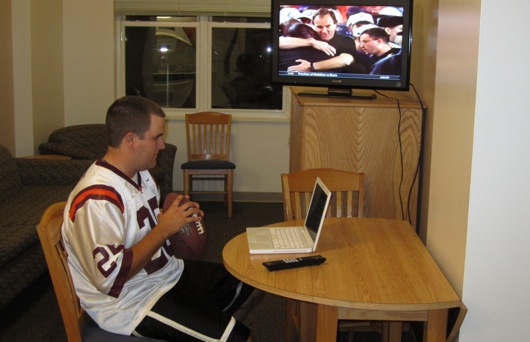'Fantasy' captures Mason sports fans, adds new dimension to Sunday football

Marshall Tinsley, a senior marketing major, tracks his fantasy team’s stats as he watches NFL games on Sundays. This is his third year participating in fantasy football. (photo illustration, Joshua Apple)
On NFL Sundays, fans used to sit on the couch and watch the games, perhaps with little personal interest unless their favorite team was playing. Watching football was arguably more of a passive activity.
Those days are long gone. They have been replaced by a more active and involved -- yet even more virtual-- experience of football and other professional sports. Adding a new dimension to every pass and play, online "fantasy" has changed the game.
Nowadays, fans can sit in front of the television with their eyes glued to the screen in anticipation, not of their favorite player scoring, but rather, of one of their fantasy players scoring. These viewers are no longer just fans; they are managers, coaches and statisticians.
And there's swarms of managers, coaches and statisticians at George Mason University.
Fantasy sports have been spreading rapidly over the past few years, especially among college students. The number of students at Mason, however, who participate in fantasy sports is perhaps beyond measure. Many students -- and no, not just guys -- are involved with fantasy football, as well as fantasy basketball, baseball and even hockey. It's part of Patriot culture.
Senior D.J. Califano, a business management major, has been playing fantasy football for two years. Though he has dabbled with fantasy basketball, he prefers football.
“Unlike basketball or baseball, with football you have a week to prepare so it makes it a little more manageable,” said Califano.
Califano’s team began the season 5-0, but fell to 5-1 last Sunday after losing to the undefeated, first-place team in his league.
“Usually I just watch Colts games, but for the first time I actually find myself watching the other games’ scores,” Califano said. “When I see that a team scores that has one of my players, I instantly run to the computer to see how they scored.”
Califano is certainly not the only Mason student partaking in the Sunday ritual. John Moorhead, a senior history major and a member of the Mason club football team, has been playing fantasy football for seven years. This year, he is in two leagues, but he doesn’t see this as unusual.
“If I had to guess, I would say 50 percent of the guys at George Mason play fantasy football,” Moorhead said. “I feel like Mason is really diverse and fantasy is so popular that I would think half of the guys here do it.”
Unbeknownst to non-fantasy players, the world of fantasy football often requires a lot of time, effort, and, of course, research. Trades are made, players are added and dropped, stats are analyzed and line-ups must be set prior to the 1 p.m. deadline on Sundays.
“I spend maybe two hours a week on fantasy, especially if there’s two sports going on at once,” freshman Joe Buttgereit said.
Buttgereit has been playing fantasy football for four years and is currently in three different leagues. He also plays fantasy baseball and basketball every year, and has tried hockey once.
“I like football the most because you don’t have to change your lineup every single day and because football is my favorite sport to watch,” Buttgereit said.
Football leagues, whether on ESPN or Yahoo!, typically consist of a minimum of 10 teams. The season begins with a draft, and the schedule is created randomly. Each team is matched up against one other team every week. The season ends with a playoff system to crown the fantasy champion.
Starting line-ups are comprised of a quarterback, varying number of running backs and wide receivers, a tight end, a kicker and a team defense.
Thus, fantasy athletes have a lot riding on the performances of a large variety of athletes on the field, especially for people like sophomore Alec Kormanec who are currently in four different football leagues.
“I love football so I would watch games anyway, but fantasy makes a lot of people more interested in football than they would have been because they want to see how the players they have are doing,” Kormanec said.
The NFL is averaging 18.9 million viewers per game, which is up nine percent from last year, according to ESPN. Viewership on the four major football networks, CBS, FOX, NBC and ESPN, is at an all-time high.
“Fantasy football makes football better, it makes people watch games they would have never watched before,” Califano said.
The NFL has hours of fantasy prediction coverage every Sunday. Now they have even created NFL Red Zone, which is airs on NFL Network and shows every touchdown scored in every game so fantasy participants can see which players are doing well.
“If one of my players was playing and it was on TV, I am guaranteed to watch it,” Califano said. “Even if it’s a Raiders-49ers game, something I would have never watched before, I’m going to watch because I have the Raiders running back.”
